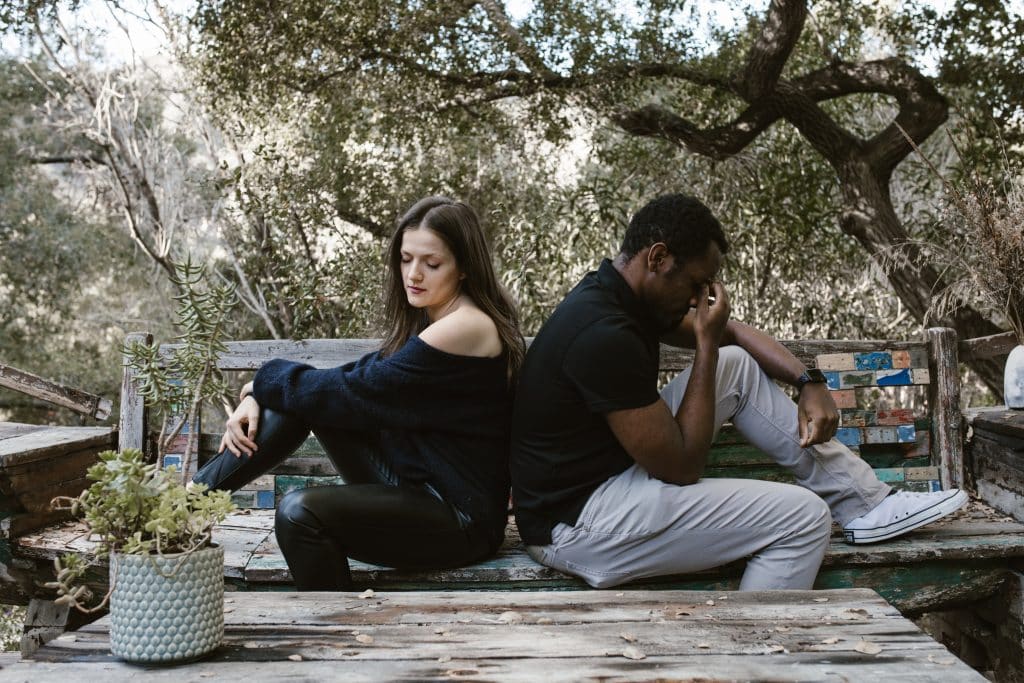Avoidant Attachment Style: Causes & Symptoms

Published on July 2, 2020 Updated on April 14, 2024
The avoidant attachment style (referred to as anxious-avoidant in childhood) is one of the three insecure adult attachment styles identified in psychological literature.
Caregivers (usually parents) who are strict and emotionally distant, do not tolerate expressions of feelings, and expect their child to be independent and tough might raise children with an avoidant attachment style.
Avoidant attachment in adults may, from the outside, look like self-confidence and self-sufficiency. This is because the avoidant attachment style causes a low tolerance for emotional or physical intimacy and, sometimes, struggles with building long-lasting relationships. Furthermore, in the workplace, adults with avoidant attachment are often seen as the independent, “lone wolf” type. However, due to their self-sufficiency, they may also be high achievers.
It is, however, possible to heal from the avoidant attachment style. With increased understanding, the correct strategies, and therapy when needed, adults with the avoidant attachment style can form healthier outlooks and behaviors, and develop a more secure attachment style.
In this article, we will cover the most common questions around avoidant attachment:
- How does attachment form in early childhood?
- How do children develop insecure attachment styles?
- What specifically causes avoidant attachment in children?
- What are symptoms of avoidant attachment in adults?
- What are relationships with avoidant adults like?
- Can you change an avoidant attachment style?
- How to heal from avoidant attachment?
What Is the Avoidant Attachment Style?
Have you ever wondered why some people do not want to depend on or truly connect with anyone, even when in a relationship? Most of us aim to build strong relationships throughout our lives.
We are ‘hungry’ for love and affection. Why? Because emotional intimacy has many advantages. Namely, we are able to share our thoughts and feelings openly, we receive support and reassurance, we feel heard, appreciated, valued, and consequently, we feel calm and safe.
Emotional closeness can provide us with a feeling of stability – we are not going through life alone; we have someone to rely on. If we feel safe and valued by others, we are also able to maintain a higher self-esteem and a positive outlook on life.
If you are someone that needs to have close relationships and wants to rely on others (and have others rely on you), you have probably wondered why some people lack these basic human desires. How do they even make it work?
The truth is, this is most often not a conscious choice. The way we form relationships as adults has a lot to do with the way we formed our first social bonds as children with our caregivers.
Attachment theory is well-known and researched in the field of Psychology. Psychiatrist and psychoanalyst John Bowlby and his attachment theory shed light on and explain this phenomenon.
Four adult attachment styles were categorized based on his theory:
- Anxious (also known as preoccupied)
- Avoidant (also known as dismissive)
- Disorganized (also known as fearful-avoidant)
- Secure
Don’t know your attachment style? Take our short 5 minute Attachment Style Quiz to find out now. It’s completely free.
How do children form secure attachment in early childhood?
Attachment theory suggests that our early relationships with our caregivers (in childhood) set the stage for how we build relationships in the future (in adulthood).
The behavior of our caregivers is the first example of social interactions that we are presented with. It thus becomes informative of how relationships work.
Are other people going to take care of me? Can I trust them? Can I rely on them?
When raising a baby in a secure environment, where the caregivers are emotionally available and responsive to the baby’s needs, the answers to these (subconscious) questions will probably be yes. This is what we call a secure attachment.
How insecure attachment develops in childhood
However, when the child perceives that their basic and emotional needs are not met, they will have a hard time trusting people. Social bonds might be perceived by such children as not safe or stable. This is how a child forms an insecure attachment.
Let’s get back to that person you know, who is self-sufficient and does not (want to) rely on others. Based on attachment theory, we would categorize his or her attachment style as an insecure attachment style. It is known, more specifically, as avoidant/dismissive.
How do children develop an anxious-avoidant attachment style?

The development of an anxious-avoidant attachment style in a child has much to do with the emotional availability of their caregivers. The caregivers do not necessarily neglect the child in general; they are present.
Nevertheless, they tend to avoid the display of emotion and intimacy and are often misattuned to the child’s emotional needs. Such caregivers are reserved and seem to back off when the child reaches out for support, reassurance and affection.
The caregivers are likely to become more distant as the situation gets more emotionally dense. They might become overwhelmed and want to get out. This is when their unavailability would be most evident.
The child expresses a need for closeness, but instead of receiving it, they perceive that the door is shut in their face. Parents whose children become avoidant might not only avoid expressing their own feelings.
They might also disapprove of and not tolerate any notable display of emotions from their children, regardless of whether it is negative (sadness / fear) or positive (excitement / joy).
When such display of emotions occurs, caregivers can become angry and try to disrupt the child’s behavior by telling the child to toughen up. The parent expects the young child to behave independent, serious, and reserved.
Being raised in such an environment is likely to cause an avoidant attachment style. Most often, the caregivers have this attachment style themselves. Since the parent was raised that way, they pass it on, unintentionally, to the next generation.

Symptoms of avoidant attachment style in adults
Adults with the dismissive / avoidant attachment style seem to be pretty happy about who they are and where they are.
They might be very social, easy-going, and fun to be around. In addition, these individuals might have a lot of friends and/or sexual partners. Generally speaking, they are not alone or lonely.
Avoidant adults tend to be independent. Their self-esteem is high and they do not rely on others for reassurance or emotional support.
Such individuals might invest in their professional development and are likely to build up their confidence on each personal success. They seem to be in control.
How does an avoidant adult behave in relationships?
For avoidant adults, social interactions and bonds remain on the surface. In order for a relationship to be meaningful and fulfilling, it has to become deep. That’s when you would ‘hit a wall’ when dealing with avoidant attachment style and relationships.
These individuals will let you be around them, but will not let you in. They tend to avoid strong displays of closeness and intimacy. As soon as things get serious, dismissive/avoidant individuals are likely to close themselves off.
At this point, such people might try to find a reason to end a relationship. They might be highly annoyed by their partner’s behavior, habit, or even physical appearance. Consequently, they start drifting off and distancing themselves from the partner. Adults with this attachment style believe that they do not need emotional intimacy in their lives.
This is a direct result of their upbringing. Their caregivers showed them that people cannot be relied on. Whenever they sought emotional support in the past, it was not provided. They simply stop seeking or expecting it from others. It’s as if they have ‘turned off the switch’.

To the avoidant adult, emotional closeness and intimacy are often off the table
From the outside, an adult with an avoidant attachment style might look confident, strong, and together. This does not mean, however, that this person is not suffering or making those around him/her suffer.
To the avoidant adult, emotional closeness and intimacy are often off the table. Not because they will not reap benefits, but because they do not know how.
Either way, not being able to build a deep, meaningful, and long-lasting relationship can be painful for people with this attachment style. It can also be heart-breaking for the ones who love them.
Furthermore, having an avoidant attachment style as a parent is likely to affect your child’s attachment style. If you have it, you will probably pass it on.
I may have avoidant attachment… now what?
If you recognize the dismissive/avoidant attachment style in yourself or you realize you are dating someone with avoidant attachment style, what can you do?
The key is to admit and realize that the ‘switch’ on emotional intimacy has to be turned on. This might be challenging and require a lot of effort.
What do I feel? The avoidant adult needs to start paying attention to the emotional and physical sensations that come up around (emotional) intimacy. Self-reflection might help one make sense of and analyze existing patterns.
What do I need? Another essential step is exploring, understanding, and eventually expressing emotional needs.
What should I do? At some point, the avoidant adult might be able to start working on building closer relationships with people. They could follow a step-by-step approach to letting others in and responding to the emotional needs of close ones.
Can avoidant adults change their attachment style?
Obviously, working with a therapist on this pattern would potentially be the most beneficial way to move forward with earning secure attachment. If that’s not an option for you, we have online courses for you to move forward.
Either way, if you want to change your attachment style, you need to put effort in it. Whether you are working through it with a close friend, a therapist, or a book, consistency and effort are fundamental.
If you prefer to go the route of a workbook, we recently released our first series of attachment style digital workbooks.
Our avoidant attachment style digital workbook includes:
- 199 pages & 32 practical exercises
- How avoidant attachment affects you in over 10 different areas of life
- 8 case studies on avoidant attachment
- Groundbreaking and up-to-date research on avoidant attachment
- Section recaps and areas for reflection
FAQs
We are frequently asked some recurring questions about the avoidant attachment style. We’re going to go through some of these to better help you understand the phenomenon of avoidant attachment.
How can I heal an avoidant attachment style?/How can I fix an avoidant attachment style?
The answer to this question isn’t necessarily simple: We’re all unique with individual needs. Having said as much, the roots of an avoidant attachment style are in a childhood of perceived rejection. Therefore, if you or someone you love has an avoidant attachment, then you may have shut your attachment system down. This means that you may withdraw from emotional closeness and intimacy because you’ve convinced yourself that you don’t need it. However, we all need love–and the only way to heal is to open yourself up to opportunities for it.
The best way of healing is to process your issues around relationships with a mental health professional. Yet, if this isn’t an option for you, there are other ways of becoming more self-aware and open. For example, dedicated workbooks and strategies that target avoidant attachment in a phased, gentle manner can be of great assistance.
Is it possible to date with an avoidant attachment style?
The answer to this question is, yes. Of course, it is possible to date with an avoidant attachment style. However, how to date with an avoidant attachment style may look quite different to those with a secure, anxious, or disorganized style.
You may need to recognize your boundaries and how you enact them–after all, even though you may be uncomfortable with emotions, the likelihood is that the person you’re dating will require you to open up from time to time.
Again, self-work can make dating with an avoidant attachment style an easier process, and this is best done with a therapist. Yet, you can still make big strides through more self-directed strategies such as workbooks and courses dedicated to the avoidant attachment style.
Do avoidant attachment men feel love?
The question of whether men with an avoidant attachment style feel love is a common one, yet it also perpetuates a myth about people with an avoidant attachment style in general. For one thing, both men and women develop the avoidant attachment style, even though it is predominantly associated with men.
Another point is that, of course, avoidant attachment men feel love. The difference is that they struggle to both show and accept it. Remember, their early attempts for affection were likely rejected, so they internalized the message that people will reject their attempts and brought this message into their adult lives.
How can I deal with avoidant attachment in relationships?
If you’re wondering how to deal with avoidant attachment in relationships, the answer will depend on whether you’re the one with the avoidant attachment style, or if you’re dating someone with it.
If you’re the one with avoidant attachment, make sure you check out our guide Avoidant Attachment in Relationships for assistance. And remember, if it’s an issue you can’t solve by yourself, a trained couples therapist may be able to help.
Final Words on the Avoidant Attachment Style Causes and Symptoms
The avoidant attachment style is one of the three insecure attachment styles. Avoidant attachment is characterized by withdrawal from emotional closeness, denial of emotions, independence, and self-sufficiency.
It’s important to understand that although adults with the avoidant attachment style may act as though they don’t need love, the opposite is true–they need love just as much as everyone else. However, their early years didn’t equip them with the ability to show and receive affection and emotional closeness.
It’s clear that the avoidant attachment style can be difficult both for those with it and for the people who love someone with avoidant attachment. Yet, attachment styles are not a life sentence: If you have an avoidant attachment style, it is always possible to heal and grow. Tuning into your emotions, the needs of others, and further understanding your attachment style is an excellent place to start.
Remember, if you want to achieve a more secure attachment style, therapy with a trained mental health professional is the best situation in which to do so. In a relationship with a therapist, someone with an avoidant attachment can learn how to trust in others, become more aware of their own emotions, and open up more in relationships.
Sources:
Ainsworth, MD, Bell, SM.(1970). Attachment, exploration, and separation: Illustrated by the behavior of one-year-olds in a strange situation. Child Development, 41(1), 49-67.
Bowlby, J.(1982). Attachment and Loss: Volume 1 Attachment. 2nd ed. New York: Basic Books.
Mikulincer, M., Shaver, P.R. (2007). Attachment in Adulthood: Structure, Dynamics, and Change. Guilford Press.












 Get mental health tips straight to your inbox
Get mental health tips straight to your inbox








